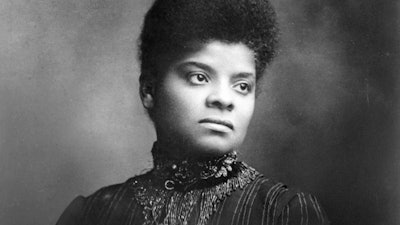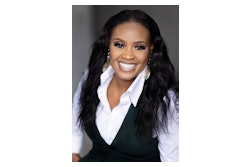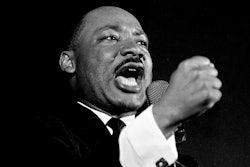 Journalist and NAACP co-founder, Ida B. Wells-Barnett.
Journalist and NAACP co-founder, Ida B. Wells-Barnett.
“Eternal vigilance is the price of liberty.”
Those words come from the pen of Ida B. Wells-Barnett, written in her autobiography, an unfinished work she began one year before her death in 1931. Wells-Barnett was a lifelong fighter for the truth, documenting the racial violence of a post-Reconstruction America by reporting and tracking lynchings. Her contributions to civil rights, equality, and the field of journalism are often forgotten. But Columbia University’s Graduate School of Journalism is working to set it right.
On March 25, Wells-Barnett’s 162nd birthday, a bust of the journalist was unveiled in the school’s main hall, greeting students and guests when they enter. Journalists and scholars, including Nikole Hannah-Jones, creator of The 1619 Project and founder of the Center for Journalism and Democracy at Howard University, and Kimberlé Crenshaw, professor at the University of California Los Angeles School of Law and Columbia Law School, spoke about why Wells-Barnett’s legacy is one that deserves recognition, and how her work and courage must be replicated to confront the troubles of today and tomorrow.
“We tend to think of the U.S. as a nation that’s moving forward and then experiences a period of backlash, when it’s the inverse,” said Hannah-Jones. “[America] is a country that never wanted a multiracial democracy. We’re in a period of massive retrenchment, and not recognizing how dangerous of a period we’re in. Our democracy is on the point of failure.”
Hannah-Jones said this flashpoint exists whether or not Donald Trump is reelected in November, adding that threats against fields of study that dismantle white supremacy, like Critical Race Theory (CRT) and Diversity, Equity, and Inclusion (DEI), have gained significant footholds in society thanks to conservative legislation and a negligent and participatory media.
“American media doesn’t want to feel they are being left out,” said Hannah-Jones. “They’re so afraid of being ‘liberal,’ they don’t tell the truth. If democracy fails, it’s because the fourth estate failed. [A free press] is the firewall of democracy. We don’t have enough people like ourselves trying to write the correct story.”
Crenshaw said that institutions have a clear role to play in defending DEI, CRT, and the fields of study surrounding that work, yet they have been noticeably quiet and acquiescent to conservative voices. Crenshaw said she once believed that academic freedom and higher education’s pursuit of ideas would be enough to rouse institutional support for DEI and CRT. Instead, she said, institutions are effectively “giving hecklers veto power.”
“When [conservatives] demonize CRT, they demonize your thinking, every moment that you realized color blindness is a myth, that color blindness is a race-conscious project to erase our capacity to dismantle white supremacy,” said Crenshaw. “Every time you give your child ‘the talk,’ or put your hands at 10:00 and 2:00 on the steering wheel when you see flashing lights behind you, you are practicing CRT. But that’s the thing they say you can no longer teach, talk about, or think. I watch and I wonder, ‘Where is everybody at? Why are they not stepping up?’”
Wells-Barnett was born in 1862 into chattel slavery. Her young years were flavored with the promise of a true democracy during Reconstruction, but after its end in 1877, she watched an apartheid nation turn blind eyes to the brutal and deadly violence inflicted on its Black citizens. In 1892, three successful Black grocers in Memphis, including Thomas Moss, who was a friend of Wells-Barnett, were lynched by a white mob.
After documenting the event at the time, Wells-Barnett wrote later in her autobiography, the event “opened my eyes to what lynching really was. An excuse to get rid of Negros who were acquiring wealth and property and thus keep the race terrorized and keep them down.”
Wells-Barnett’s reporting pioneered the fields of investigative and data journalism. Eventually, she became one of the founders of the National Association for the Advancement of Colored People (NAACP), a civil rights organization still working to end racial inequality.
 Journalists Joy-Ann Reid, Marquita Pool-Eckert, Dorothy Gilliam, and Jenisha Watts.
Journalists Joy-Ann Reid, Marquita Pool-Eckert, Dorothy Gilliam, and Jenisha Watts.
“These weren’t two equal and opposite sides. This pretend neutrality didn’t make any sense. That was actually so influential, that ultimately, you wind up with a Fox News,” said Reid. “There was this sense among a lot of white segregationists and people on the far right that the media was inherently biased against conservatives. What they meant was, the media could see a villain and a victim and tell the difference. It was through the advocacy of Ida B. Wells that really pushed it, both from within the NAACP and in her journalism.”
Hannah-Jones said studying Ida B. Wells-Barnett forces Americans to make a choice, to “decide what kind of country we want to be.” Wells-Barnett never saw racial justice in her lifetime, nor witnessed any anti-lynching legislation passed. Yet she never stopped pushing for something better.
“Sometimes you write for today, sometimes you write for the future, so people can’t look back and say we didn’t know or we didn’t know better,” said Hannah-Jones. “It’s critical for us to write the things that need to be written, to bear witness, even if we don’t have the power to change it.”
Liann Herder can be reached at lherder@diverseeducation.com.



















